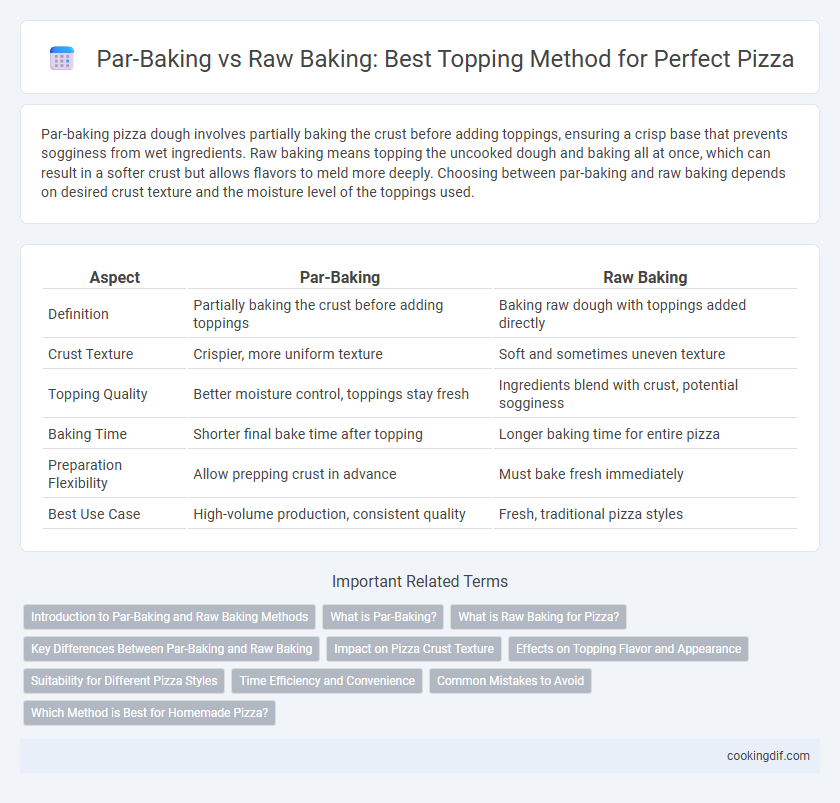Par-baking pizza dough involves partially baking the crust before adding toppings, ensuring a crisp base that prevents sogginess from wet ingredients. Raw baking means topping the uncooked dough and baking all at once, which can result in a softer crust but allows flavors to meld more deeply. Choosing between par-baking and raw baking depends on desired crust texture and the moisture level of the toppings used.
Table of Comparison
| Aspect | Par-Baking | Raw Baking |
|---|---|---|
| Definition | Partially baking the crust before adding toppings | Baking raw dough with toppings added directly |
| Crust Texture | Crispier, more uniform texture | Soft and sometimes uneven texture |
| Topping Quality | Better moisture control, toppings stay fresh | Ingredients blend with crust, potential sogginess |
| Baking Time | Shorter final bake time after topping | Longer baking time for entire pizza |
| Preparation Flexibility | Allow prepping crust in advance | Must bake fresh immediately |
| Best Use Case | High-volume production, consistent quality | Fresh, traditional pizza styles |
Introduction to Par-Baking and Raw Baking Methods
Par-baking involves partially baking the pizza crust before adding toppings, ensuring a crisp base that prevents sogginess and supports heavy ingredients. Raw baking means applying toppings to uncooked dough and baking it entirely at once, resulting in a softer crust with blended flavors as toppings cook directly on the dough. Both methods impact texture, moisture control, and overall pizza quality, guiding chefs in choosing the ideal technique based on topping type and desired crust consistency.
What is Par-Baking?
Par-baking is a partial baking process where the pizza crust is baked until it is firm but not fully cooked, allowing toppings to be added later without overcooking the dough. This method helps achieve a crispier crust and prevents sogginess from wet toppings during the final bake. Par-baked crusts are often used in commercial settings to streamline preparation and maintain consistent quality.
What is Raw Baking for Pizza?
Raw baking for pizza involves placing uncooked dough directly into the oven with toppings applied before baking, allowing the crust and ingredients to cook simultaneously. This method preserves the freshness and texture of toppings such as vegetables and meats, as they cook naturally during the baking process. Raw baking requires precise oven temperature control, typically between 450degF to 500degF, to ensure even cooking and prevent soggy crusts.
Key Differences Between Par-Baking and Raw Baking
Par-baking involves partially baking the pizza crust before adding toppings, ensuring a crisp base and preventing sogginess, while raw baking places toppings on uncooked dough, allowing flavors to meld but risking a softer crust. Par-baked crusts offer consistent texture and reduced baking time when reheated, making them ideal for commercial use. Raw baking provides a fresher taste and traditional texture but requires precise timing to avoid undercooked dough or overdone toppings.
Impact on Pizza Crust Texture
Par-baking pizza crust partially cooks the dough before adding toppings, resulting in a firmer and crispier texture that prevents sogginess from moisture-rich ingredients. Raw baking, which involves baking the dough with toppings from an uncooked state, often produces a softer, chewier crust that absorbs topping juices more readily. Choosing par-baking enhances crust structure and is ideal for heavy or moist toppings, while raw baking preserves a traditional, tender bite.
Effects on Topping Flavor and Appearance
Par-baking pizza dough partially cooks the crust, providing a stable base that prevents sogginess and allows toppings to cook evenly, which enhances topping flavor by preserving moisture and intensifying aromas. Raw baking involves baking the dough and toppings simultaneously, often resulting in toppings that can overcook or undercook, affecting their texture and flavor negatively. Par-baking optimizes the contrast between crispy crust and perfectly cooked toppings, improving overall appearance with vibrant colors and appealing textures.
Suitability for Different Pizza Styles
Par-baking pizza dough creates a partially cooked crust that holds toppings better, ideal for thick-crust styles like Detroit or Sicilian pizzas where a crisp interior is desired. Raw baking allows the dough to rise fully with toppings, perfect for thin-crust Neapolitan or New York-style pizzas that require a softer, more pliable base. Selecting par-baking or raw baking techniques depends on the desired texture and moisture balance tailored to specific pizza varieties.
Time Efficiency and Convenience
Par-baking pizza crusts significantly reduces overall bake time by partially cooking the dough before adding toppings, resulting in faster preparation and consistent texture. Raw baking with toppings requires longer oven time to fully cook both dough and ingredients, which can lead to uneven cooking or soggy crusts if not carefully managed. Par-baking enhances convenience in commercial kitchens by allowing advance preparation, quicker assembly, and faster service during peak hours.
Common Mistakes to Avoid
Par-baking pizza crust before adding toppings often leads to overcooked edges or a dry texture if not timed precisely. Raw baking with toppings can cause uneven cooking, resulting in soggy centers or undercooked dough. Avoid common mistakes such as underestimating baking times for thicker crusts and overloading with moist toppings, which impact pizza quality.
Which Method is Best for Homemade Pizza?
Par-baking pizza dough partially cooks the crust, ensuring a crisp base that prevents sogginess when adding moist toppings, ideal for homemade pizzas with heavy or watery ingredients like fresh tomatoes or vegetables. Raw baking involves baking the pizza dough and toppings together from scratch, preserving the freshness and texture of ingredients but risking a softer crust if not managed carefully. For homemade pizza, par-baking offers better control over crust texture and topping doneness, making it the preferred method for a balanced, crispy, and flavorful result.
Par-baking vs Raw baking for topping method Infographic

 cookingdif.com
cookingdif.com